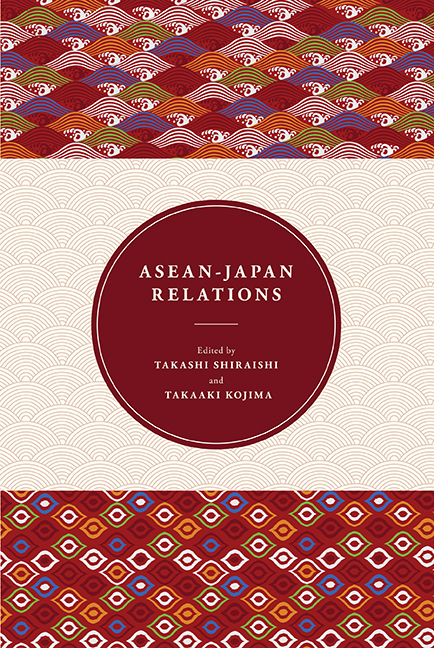Book contents
- Frontmatter
- Contents
- Preface
- About the Contributors
- 1 An Overview of Japan-ASEAN Relations
- 2 Japan's Relations with ASEAN
- 3 Approaches toward Regionalism: Japan, China and the Implications on ASEAN
- 4 The New Japan-ASEAN Partnership: Challenges in the Transformation of the Regional Context in East Asia
- 5 ASEAN-Japan Strategic Partnership and Regional Integration: Impacts and Implications
- 6 ASEAN-Japan Cooperation on Maritime Non-Traditional Security Issues: Toward a New Paradigm
- 7 Japan's Evolving Security Concerns in Maritime Southeast Asia: From Safety of Navigation to “Lake Beijing”
- 8 Evolution of Institutions and Policies for Economic Integration in East Asia: The Rise of China and Changes in the Regional Order
- 9 Managing Integration in East Asia: Behind Border Issues in Japan-ASEAN Trade Agreements
- 10 Regional Financial Cooperation in East Asia: Development and Challenges
- 11 Japanese Development Assistance to ASEAN Countries
- 12 Japanese Foreign Direct Investment in the ASEAN-4 Countries
- 13 Japan's Triple Tsunami
- 14 ASEAN-Japan Relations: A Singapore Perspective
1 - An Overview of Japan-ASEAN Relations
Published online by Cambridge University Press: 21 October 2015
- Frontmatter
- Contents
- Preface
- About the Contributors
- 1 An Overview of Japan-ASEAN Relations
- 2 Japan's Relations with ASEAN
- 3 Approaches toward Regionalism: Japan, China and the Implications on ASEAN
- 4 The New Japan-ASEAN Partnership: Challenges in the Transformation of the Regional Context in East Asia
- 5 ASEAN-Japan Strategic Partnership and Regional Integration: Impacts and Implications
- 6 ASEAN-Japan Cooperation on Maritime Non-Traditional Security Issues: Toward a New Paradigm
- 7 Japan's Evolving Security Concerns in Maritime Southeast Asia: From Safety of Navigation to “Lake Beijing”
- 8 Evolution of Institutions and Policies for Economic Integration in East Asia: The Rise of China and Changes in the Regional Order
- 9 Managing Integration in East Asia: Behind Border Issues in Japan-ASEAN Trade Agreements
- 10 Regional Financial Cooperation in East Asia: Development and Challenges
- 11 Japanese Development Assistance to ASEAN Countries
- 12 Japanese Foreign Direct Investment in the ASEAN-4 Countries
- 13 Japan's Triple Tsunami
- 14 ASEAN-Japan Relations: A Singapore Perspective
Summary
Something interesting has happened to the Japan-ASEAN (Association of Southeast Asian Nations) relationship over the past 15 years.
Things had begun on a hopeful note. Japan took a series of initiatives in regional cooperation up to the 1997–98 East Asian economic crisis and did everything it could to help the crisis-hit countries. The ASEAN-Japan Summit was held for the first time in 1997 at the initiative of Prime Minister Hashimoto Ryutaro (1996–98), who announced that Japan would work closely with ASEAN to stabilize Asian currencies and the Asian financial market. Japan, under his leadership, also proposed to establish an Asian Monetary Fund to provide liquidity support for the crisis-hit countries. In 1998, Finance Minister Miyazawa Kiichi spearheaded an initiative to provide funds to reflate the crisis-hit economies, which led to the establishment of the Chiang Mai Initiative in 1999. The ASEAN-Japan Summit, which was institutionalized along with the ASEAN Plus Three (APT) in 1999, has been held every year since. In 2002, Prime Minister Koizumi Junichiro (2001–06) called for a Japan-ASEAN economic partnership agreement as a first step to building an East Asia community. The Japan-ASEAN Commemorative Summit was held in Tokyo in 2003 when Japan signed the Treaty of Amity and Cooperation (TAC). Japan, together with Indonesia and Singapore, played a crucial role in establishing the East Asia Summit (EAS) in 2005, which extended its membership beyond APT to India, Australia, and New Zealand. In the wake of the 1997–98 crisis, ASEAN Plus processes thus emerged as a major framework for regional cooperation, with ASEAN as the hub.
Subsequently Japan-ASEAN collaboration stagnated and Japan's profile declined in the region. There were domestic and regional reasons for the stagnation. With prime ministers changing practically every year from 2006–12 after Koizumi stepped down, Japan hardly took any important diplomatic initiatives concerning ASEAN. Japan's economic stagnation also led to the decline in its Official Development Assistance (ODA) and Foreign Direct Investment (FDI) to ASEAN. On the other hand, China has risen economically and hence in its power and profile in ASEAN. It has also taken its own initiatives in shaping the region, such as its FTA proposal, accession to TAC, and the Declaration on the South China Sea.
- Type
- Chapter
- Information
- ASEAN-Japan Relations , pp. 1 - 16Publisher: ISEAS–Yusof Ishak InstitutePrint publication year: 2013



